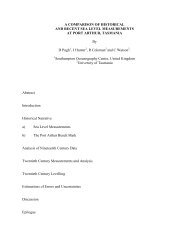Comparison of Observed Temperature and Salinity Changes in the ...
Comparison of Observed Temperature and Salinity Changes in the ...
Comparison of Observed Temperature and Salinity Changes in the ...
You also want an ePaper? Increase the reach of your titles
YUMPU automatically turns print PDFs into web optimized ePapers that Google loves.
158 JOURNAL OF CLIMATE<br />
VOLUME 16<br />
b. Numerical model<br />
The model we will look at here is <strong>the</strong> coupled ocean–<br />
atmosphere model, HadCM3 (Gordon et al. 2000), developed<br />
at <strong>the</strong> Hadley Centre. The major differences<br />
between this coupled model <strong>and</strong> <strong>the</strong> previous version<br />
(Johns et al. 1997) occur <strong>in</strong> <strong>the</strong> ocean component, which<br />
has higher horizontal resolution <strong>and</strong> employs <strong>the</strong> Gent<br />
<strong>and</strong> McWilliams (1990) scheme to represent mix<strong>in</strong>g due<br />
to eddies. The <strong>in</strong>troduction <strong>of</strong> <strong>the</strong>se <strong>and</strong> o<strong>the</strong>r improvements<br />
meant that <strong>the</strong> coupled model no longer needed<br />
artificial flux adjustments to prevent <strong>the</strong> model drift<strong>in</strong>g<br />
to an unrealistic state <strong>and</strong> exact fluxes are exchanged<br />
between <strong>the</strong> atmosphere <strong>and</strong> <strong>the</strong> ocean on a daily basis.<br />
The ocean component <strong>of</strong> <strong>the</strong> model is based on <strong>the</strong> Cox<br />
(1984) model with a horizontal resolution <strong>of</strong> 1.25 <strong>in</strong><br />
both <strong>the</strong> north–south <strong>and</strong> east–west direction <strong>and</strong> 20<br />
vertical levels. The reader is referred to Gordon et al.<br />
(2000) for details <strong>of</strong> <strong>the</strong> model.<br />
Here we will exam<strong>in</strong>e two experiments; firstly, <strong>the</strong><br />
control experiment (CTL) <strong>and</strong> secondly an anthropogenic<br />
climate change experiment B2. CTL is <strong>in</strong>itialized<br />
with <strong>the</strong> temperature <strong>and</strong> sal<strong>in</strong>ity <strong>of</strong> <strong>the</strong> ocean given by<br />
<strong>the</strong> climatology <strong>of</strong> Levitus <strong>and</strong> Boyer (1994) <strong>and</strong> with<br />
both <strong>the</strong> atmosphere <strong>and</strong> ocean at rest. While <strong>the</strong> oceanic<br />
<strong>and</strong> atmospheric heat budgets come <strong>in</strong>to balance with<strong>in</strong><br />
10 yr <strong>in</strong> CTL (Gordon et al. 2000), this is not <strong>the</strong> case<br />
for <strong>the</strong> freshwater budgets, which require a timescale <strong>of</strong><br />
<strong>the</strong> order <strong>of</strong> 300–400 yr to come <strong>in</strong>to balance (Pardaens<br />
et al. 2001, manuscript submitted to Climate Dyn., hereafter<br />
PBGR). S<strong>in</strong>ce any imbalance will directly affect<br />
<strong>the</strong> sal<strong>in</strong>ity structure <strong>of</strong> <strong>the</strong> ocean, this means that <strong>the</strong><br />
water mass properties must have a similar timescale to<br />
<strong>the</strong> sal<strong>in</strong>ity field to reach a quasi equilibrium. For this<br />
reason, <strong>in</strong> this paper we will only look at water mass<br />
properties from year 370 onward.<br />
Experiment B2 is <strong>in</strong>itialized at year 370 <strong>of</strong> CTL. The<br />
B2 is a climate change experiment with imposed anthropogenic<br />
changes <strong>of</strong> well-mixed greenhouse gases,<br />
tropospheric <strong>and</strong> stratospheric ozone <strong>and</strong> sulphate aerosols,<br />
<strong>and</strong> is described <strong>in</strong> detail by Johns et al. (2001).<br />
The B2 is forced us<strong>in</strong>g historical emissions <strong>and</strong> concentrations<br />
from 1859 until <strong>the</strong> present, <strong>the</strong>n <strong>the</strong> IPCC<br />
B2 scenario until 2100. Experiment B2 has previously<br />
been used by Banks et al. (2000) <strong>and</strong> Banks <strong>and</strong> Wood<br />
(2002) to look at changes <strong>in</strong> water mass properties. A<br />
simpler experiment with HadCM3 based on 2% <strong>in</strong>crease<br />
per year <strong>in</strong> carbon dioxide was used by Banks et al.<br />
(2002) to underst<strong>and</strong> <strong>the</strong> causes <strong>of</strong> change <strong>in</strong> Subantarctic<br />
Mode Water <strong>in</strong> <strong>the</strong> Indian Ocean. The present<br />
paper is <strong>the</strong> first to quantitatively compare HadCM3 <strong>and</strong><br />
observations throughout <strong>the</strong> Indo-Pacific <strong>and</strong> <strong>in</strong> its exam<strong>in</strong>ation<br />
<strong>of</strong> <strong>the</strong> bas<strong>in</strong>wide modes <strong>of</strong> <strong>the</strong> Indo-Pacific.<br />
FIG. 2. <strong>Temperature</strong>–sal<strong>in</strong>ity diagrams show<strong>in</strong>g <strong>the</strong> Sou<strong>the</strong>rn Hemisphere<br />
section average water mass changes found <strong>in</strong> both (a), (c), (e)<br />
<strong>the</strong> observations <strong>and</strong> (b), (d), (f) <strong>in</strong> <strong>the</strong> HadCM3 anthropogenic climate<br />
change experiment (B2) <strong>of</strong> HadCM3 for <strong>the</strong> period shown <strong>in</strong><br />
Table 1. (a), (b): 17S; (c), (d): 32S; <strong>and</strong> (e), (f): 43S. The cont<strong>in</strong>uous<br />
l<strong>in</strong>es are <strong>the</strong> old water mass characteristics, <strong>and</strong> <strong>the</strong> dashed l<strong>in</strong>es are<br />
<strong>the</strong> new characteristics. The reader is referred to Fig. 4 to exam<strong>in</strong>e<br />
<strong>the</strong> changes <strong>in</strong> detail.<br />
3. <strong>Comparison</strong> <strong>of</strong> observed changes <strong>and</strong> coupled<br />
model changes<br />
a. Qualitative comparison <strong>of</strong> modeled <strong>and</strong> observed<br />
temperature–sal<strong>in</strong>ity properties<br />
Figure 1 shows <strong>the</strong> location <strong>of</strong> <strong>the</strong> observations used<br />
<strong>in</strong> this study (Wong et al. 1999). The dates <strong>of</strong> <strong>the</strong> observations<br />
are described <strong>in</strong> Table 1. It should be noted<br />
that <strong>the</strong> historical data are <strong>in</strong>terpolated onto <strong>the</strong> location<br />
<strong>of</strong> <strong>the</strong> modern sections <strong>and</strong> have an associated error bar<br />
to account for <strong>the</strong> effects <strong>of</strong> mesoscale variability. We<br />
will use <strong>the</strong> uncerta<strong>in</strong>ties later. For <strong>the</strong> model data we<br />
have extracted zonal sections from <strong>the</strong> annual means <strong>of</strong><br />
<strong>the</strong> years <strong>of</strong> <strong>the</strong> historical <strong>and</strong> modern observations at<br />
<strong>the</strong> same latitudes as <strong>the</strong> observed sections. We have<br />
calculated error bars for <strong>the</strong> model to account for <strong>the</strong><br />
uncerta<strong>in</strong>ty <strong>in</strong> <strong>the</strong> date <strong>of</strong> <strong>the</strong> historical data <strong>and</strong> shortterm<br />
variability <strong>of</strong> <strong>the</strong> model. This is based on <strong>the</strong> st<strong>and</strong>ard<br />
deviation <strong>of</strong> 5-yr differences <strong>in</strong> B2.<br />
Figure 2 shows temperature–sal<strong>in</strong>ity diagrams from<br />
both <strong>the</strong> modern <strong>and</strong> historical times for both <strong>the</strong> observational<br />
data <strong>and</strong> <strong>the</strong> modeled data at <strong>the</strong> three sou<strong>the</strong>rn<br />
sections; 43, 32, <strong>and</strong> 17S. The bold l<strong>in</strong>es denote<br />
<strong>the</strong> historical temperature–sal<strong>in</strong>ity pr<strong>of</strong>ile, while <strong>the</strong><br />
dashed l<strong>in</strong>es denote <strong>the</strong> modern pr<strong>of</strong>ile. In each case,<br />
<strong>the</strong> modeled <strong>and</strong> observed temperature–sal<strong>in</strong>ity pr<strong>of</strong>iles<br />
are qualitatively similar; <strong>in</strong> each pr<strong>of</strong>ile <strong>the</strong>re is a well-








